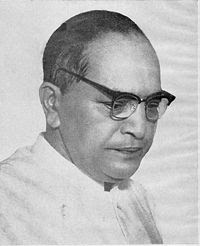

Inspiration
It was during my third standard that I remember, I had received a gift of pictorial biography of Bhimrao Ramji Ambedkar. It was more of a comic book to me rather than a story of a Dalit leader who went onto become the chief architect of the Indian Constitution. It was much later that I realized that he was A Lion Among Men. Ambedkar was born in a cast which was considered as the lowest of the low. People said that it was a sin it they offered him water to drink. But this very man framed the Constitution for the country. His entire life was one of struggles. But it’s no wonder that everyone called him ‘Babasaheb’, out of love and admiration. Bhimram Ambedkar was the lion-hearted man who fought for equality, justice and humanity
Overcoming numerous social and financial obstacles, Ambedkar became one of the first "untouchables" to obtain a college education in
Early Life
Dr.Bhimrao Ambedkar was born on April 14, 1891 in Mhow (presently in Madhya Pradesh). He was the fourteenth child of Ramji and Bhimabai Sakpal Ambavedkar. B.R. Ambedkar belonged to the "untouchable" Mahar Caste. His father and grandfather served in the British Army. In those days, the government ensured that all the army personnel and their children were educated and ran special schools for this purpose. This ensured good education for Bhimrao Ambedkar, which would have otherwise been denied to him by the virtue of his caste. Bhimrao Ambedkar experienced intense socio-economic discrimination right from the childhood. After his retirement, Bhimrao's father settled in Satara Maharashtra. Bhimrao was enrolled in the local school. Here, he had to sit on the floor in one corner in the classroom and teachers would not touch his notebooks. In spite of these hardships, Bhimrao continued his studies and passed his Matriculation examination from
Fight against untouchability
In 1920, he began the publication of the weekly Mooknayak (Leader of the Silent) in Mumbai. Attaining popularity, Ambedkar used this journal to criticize orthodox Hindu politicians and a perceived reluctance of the Indian political community to fight caste discrimination. Ambedkar established a successful legal practice, and also organised the Bahishkrit Hitakarini Sabha to promote education and socio-economic uplifting of the depressed classes. In 1927, Dr. Ambedkar decided to launch active movements against untouchability. He began with public movements and marches to open up and share public drinking water resources and also began a struggle for the right to enter Hindu temples.
He had grown increasingly critical of mainstream Indian political parties for their perceived lack of emphasis for the elimination of the caste system. Ambedkar criticized the Indian National Congress, whom he accused of reducing the untouchable community to a figure of pathos. At a Depressed Classes Conference on August 8, 1930 Ambedkar outlined his political vision, insisting that the safety of the Depressed Classes hinged on their being independent of the Government and the Congress both.
Ambedkar's prominence and popular support amongst the untouchable community had increased, and he was invited to attend the Second Round Table Conference in
In 1935, Ambedkar was appointed principal of the 
Architect of
Dr. Bhimrao Ramji Ambedkar is better remembered as the designer and formulator of the Indian Constitution in
His stint in Indian politics too did not last for a long time. His resignation from the Cabinet came in the year 1951. He contested for the Lok Sabha elections as an independent candidate in 1952 but was unfortunately defeated. However, he became a member of the Rajya Sabha the same year and would remain a member until his death.
Final Days
With passage of time, Ambedkar’s interest from politics started to shift and he aligned himself to Buddhism. After meetings with the Sri Lankan Buddhist monk Hammalawa Saddhatissa, Ambedkar organised a formal public ceremony for himself and his supporters in
Since 1948, Ambedkar had been suffering from diabetes. He was bed-ridden from June to October in 1954 owing to clinical depression and failing eyesight. He had been increasingly embittered by political issues, which took a toll on his health. His health worsened as he furiously worked through 1955. Just three days after completing his final manuscript The Buddha and His Dhamma , it is said that Ambedkar died in his sleep on December 6, 1956 at his home in
Long Live His Legacy
Babasaheb was an Indian nationalist, jurist, Dalit, political leader, activist, philosopher, thinker, anthropologist, historian, orator, prolific writer, economist, scholar, editor, revolutionary and the revivalist of Buddhism in
Ambedkar's legacy as a socio-political reformer, had a deep effect on modern

A good article, good work, keep going!
ReplyDelete*came across your blog while randomly going through orkut.